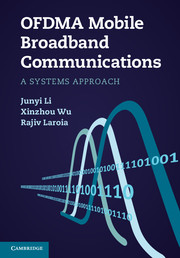Book contents
- Frontmatter
- Dedication
- Contents
- Foreword
- Preface
- List of Notation
- List of Abbreviations
- 1 Introduction
- 2 Elements of OFDMA
- 3 System design principles
- 4 Mitigation and exploitation of multipath fading
- 5 Intra-cell user multiplexing
- 6 Inter-cell interference management
- 7 Use of multiple antennas
- 8 Scheduling
- 9 Handoff in IP-based network architecture
- 10 Beyond conventional cellular frameworks
- A Overview of system operations
- B OFDM point-to-point communications
- C Brief review of channel capacity
- References
- Index
9 - Handoff in IP-based network architecture
Published online by Cambridge University Press: 05 July 2013
- Frontmatter
- Dedication
- Contents
- Foreword
- Preface
- List of Notation
- List of Abbreviations
- 1 Introduction
- 2 Elements of OFDMA
- 3 System design principles
- 4 Mitigation and exploitation of multipath fading
- 5 Intra-cell user multiplexing
- 6 Inter-cell interference management
- 7 Use of multiple antennas
- 8 Scheduling
- 9 Handoff in IP-based network architecture
- 10 Beyond conventional cellular frameworks
- A Overview of system operations
- B OFDM point-to-point communications
- C Brief review of channel capacity
- References
- Index
Summary
The central design idea of mobile broadband is to adapt wireless to the Internet, not vice-versa. Compared with its wireline counterpart, mobile broadband faces two major technical challenges: fading and interference, which make the wireless link less reliable, and mobility, which requires handoff from one cell to another as a user moves. The previous chapters describe the physical and MAC layer approaches of dealing with fading and interference and improving link reliability and system capacity. In this chapter, we will expand our scope to view the airlink as part of an end-to-end network system and address the handoff issue.
Network architecture describes the necessary functions of the network system, partitions them to a set of logical nodes, and defines the interfaces between the nodes. An end-to-end network system is usually quite complex. To handle the complexity in a scalable manner, a good design practice is to adopt a layered structure. For example, the famous open system interconnection (OSI) model defines a networking framework of implementing protocols in seven layers, namely the application, presentation, session, transport, networking, data link, and physical layers. When two nodes communicate with each other, control is passed down from a higher layer to a lower one in one node, all the way to the bottom physical layer, then over the physical channel to the other node, and finally moving up the hierarchy in that node. The TCP/IP model of the Internet simplifies the layering model to four layers, namely the application, transport, Internet, and network access layers.
- Type
- Chapter
- Information
- OFDMA Mobile Broadband CommunicationsA Systems Approach, pp. 315 - 364Publisher: Cambridge University PressPrint publication year: 2013



